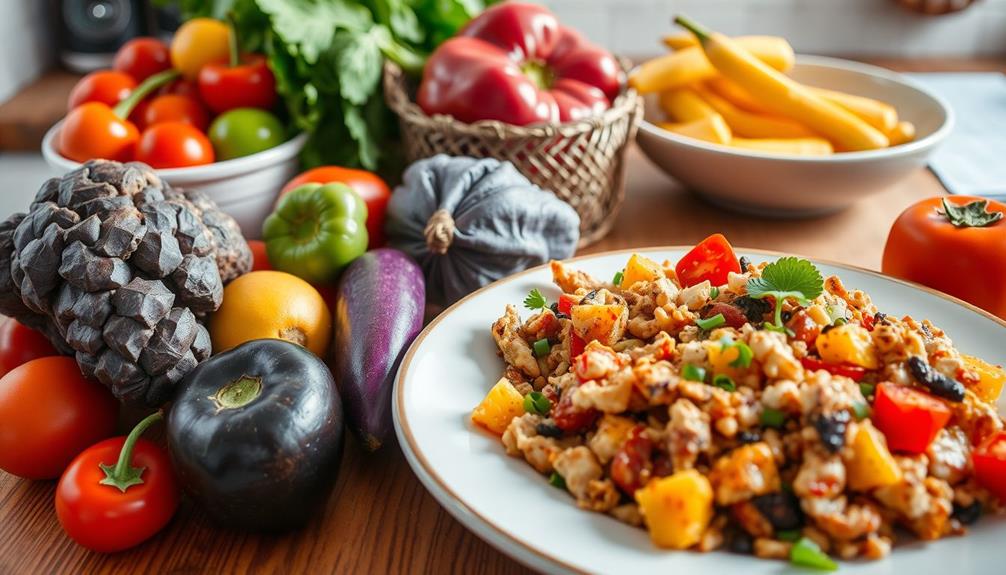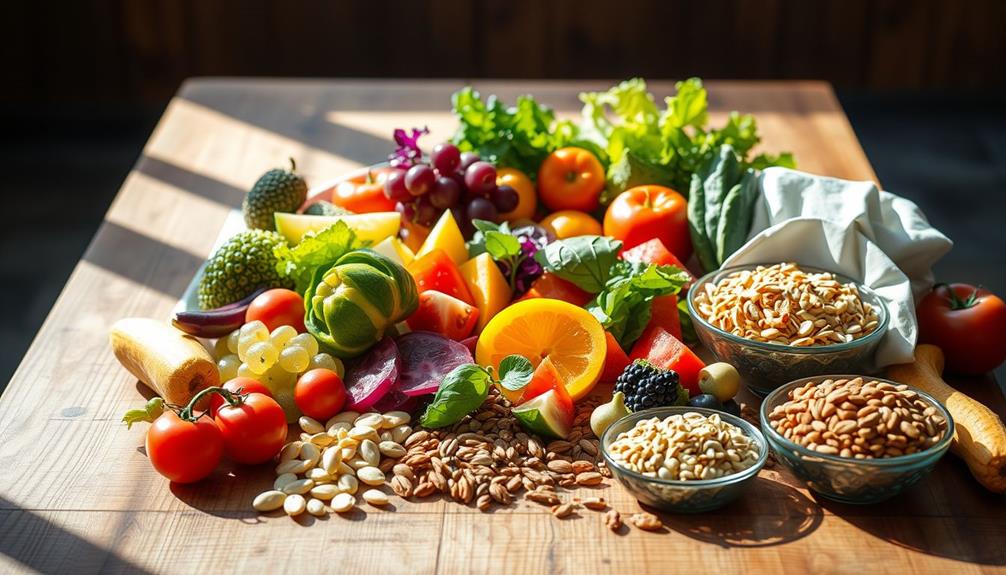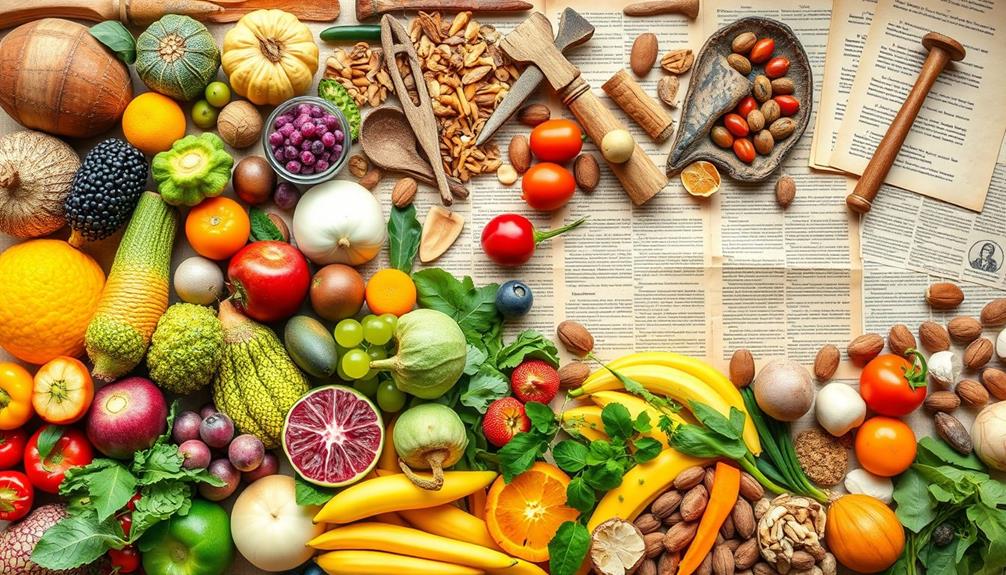A raw food diet, rich in fruits, vegetables, nuts, and seeds, comes with impressive benefits like weight loss, improved digestion, and enhanced energy levels. You'll likely notice healthier skin and a boosted immune system too. However, be cautious of potential nutritional deficiencies, especially in vitamin B12 and protein. The restrictive nature can lead to disordered eating, and meal prep might be time-consuming and costly. While enjoying the vibrant flavors and health perks, it's essential to balance your diet for overall well-being. If you're curious about detailed strategies and tips, you might find what you seek just ahead.
Key Takeaways
- Pros: Raw food diets promote weight loss and enhance digestion due to high fiber content from unprocessed fruits and vegetables.
- Pros: They increase energy levels, improve skin health, and boost immune function through nutrient-dense foods rich in vitamins and antioxidants.
- Cons: Nutritional deficiencies, particularly in vitamin B12, calcium, omega-3 fatty acids, and protein, can occur with a raw food diet.
- Cons: The restrictive nature of the diet may lead to disordered eating patterns and discomfort from high fiber intake if not adjusted gradually.
- Cons: High costs and time-consuming meal preparation may deter adherence, making it essential to plan and budget effectively.
Understanding the Raw Food Diet
The raw food diet focuses on consuming unprocessed, whole foods, primarily raw fruits, vegetables, nuts, seeds, and sprouted grains. By avoiding cooking beyond 104-118°F (40-48°C), this diet aims to preserve essential nutrients and enzymes that cooking destroys. It emphasizes a plant-based approach, though some variations include raw animal products.
One notable benefit of this diet is the high intake of antioxidants found in various raw fruits and vegetables, which can contribute to overall health, similar to the benefits of cranberry juice consumption. Meal preparation is vital in the raw food diet, requiring you to adopt specific food preparation techniques such as soaking, sprouting, dehydrating, and blending. These methods not only enhance digestibility but also improve nutrient absorption.
However, careful planning is essential to avoid nutrient deficiencies, particularly in protein, vitamin B12, iron, and calcium, which can be challenging on a strictly raw regimen.
While the diet promotes a high intake of fiber and essential nutrients, which can lead to improved digestion and overall health, it can be socially challenging and labor-intensive. You may find limited dining options, and the time invested in meal preparation might increase food waste if not managed properly.
Understanding these aspects will help you make informed decisions about whether the raw food diet aligns with your lifestyle.
Health Benefits of Raw Foods

When you embrace a raw food diet, you're tapping into a wealth of nutrient-rich foods that can boost your overall health.
This approach not only supports weight loss by keeping you full and satisfied but also enhances digestion through high fiber content, which is essential for digestive health.
As you explore these benefits, you'll likely notice increased energy levels and improved skin health, which can be attributed to the high vitamin and antioxidant levels found in raw foods boosts immune system function.
Nutrient-Rich Foods
Raw foods pack a powerful nutritional punch, offering an abundance of vitamins, minerals, and antioxidants that can greatly enhance your overall health.
By focusing on a raw food diet, you're not just enjoying tasty whole foods; you're also boosting your nutrient content considerably. Additionally, incorporating natural remedies, like those found in cold medications overview, can further support your health while on a raw food diet.
Here are four key benefits to reflect upon:
- High in Dietary Fiber: Raw foods promote healthy digestion, which can help reduce the risk of heart disease and type 2 diabetes.
- Rich in Vitamins and Minerals: Fresh fruits and vegetables are packed with essential nutrients that support your immune system and overall well-being.
- Loaded with Healthy Fats: Nuts and seeds provide the healthy fats necessary for ideal brain health and can help maintain healthy cholesterol levels.
- Natural Enzymes: Raw foods retain natural enzymes that enhance digestion and nutrient absorption, benefiting your gut health.
Weight Loss Potential
Many people find that a raw food diet can be a powerful tool for weight loss. This low-calorie diet emphasizes fruits and vegetables, which typically leads to reduced caloric intake. Studies show that participants on a raw food diet can lose significant weight, averaging about 8.4 lbs over 6.7 months.
Because you're consuming fewer added sugars and unhealthy fats, you're likely to achieve a healthier body composition and a lower body mass index (BMI). Additionally, incorporating fresh fruits and vegetables can provide vital vitamins and minerals that support overall health, similar to the benefits of a proper diet for pets.
The high fiber content of raw foods promotes satiety, helping you feel full longer and preventing overeating. This can be particularly beneficial if you're trying to manage your weight effectively.
However, it's important to be aware of the challenges that come with the raw food diet. Its restrictive nature can make long-term adherence difficult and might lead to nutritional deficiencies, which could counteract some of the weight loss benefits.
Balancing the benefits of weight loss with the risks of deficiencies is significant. Ultimately, while the raw food diet offers promising weight loss potential, consider whether it aligns with your lifestyle and nutritional needs.
Enhanced Digestion Benefits
The benefits of a raw food diet extend beyond weight loss, particularly enhancing digestion. When you embrace this lifestyle, you'll likely experience several advantages that support healthy digestion.
For instance, adopting a raw food diet can also encourage the power of imagination by fostering creativity in meal preparation and exploration of diverse foods. Additionally, many individuals find that this shift aligns with their wellness goals, promoting a more balanced approach to health.
- High Fiber Content: Raw fruits and vegetables are packed with fiber, promoting regular bowel movements and overall digestive health.
- Natural Enzymes: These unprocessed foods retain natural enzymes that aid in breaking down nutrients, potentially enhancing nutrient absorption.
- Gut Health Boost: Raw foods are rich in prebiotics that nourish beneficial gut bacteria, contributing to improved gut health.
- Digestive Comfort: Many people report reduced bloating and better digestive comfort when switching to a raw food diet, likely due to lower levels of indigestible fibers found in cooked foods.
Nutritional Drawbacks to Consider
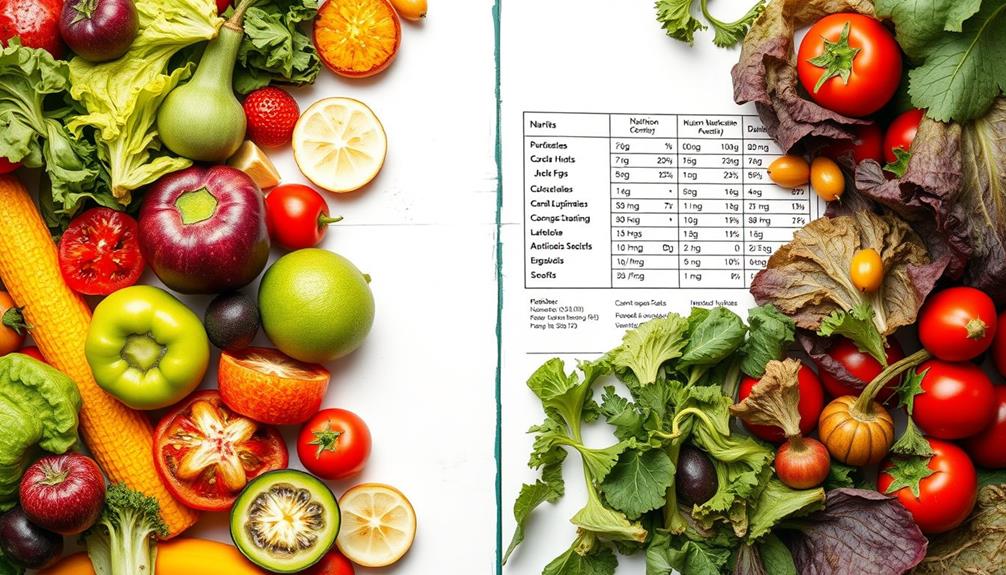
Considering nutritional deficiencies is essential when evaluating a raw food diet. While this diet may offer various health benefits, it can also lead to significant gaps in your nutrient intake. For example, you might struggle to get enough vitamin B12, calcium, and omega-3 fatty acids due to the exclusion of cooked animal products. The restrictive nature of the raw food diet often results in low body mass index (BMI) and inadequate calorie intake, which can be concerning.
Additionally, the high fiber intake from raw foods can cause digestive discomfort, leading to gas and cramping if you don't adjust gradually. It's also vital to note that cooking enhances the bioavailability of certain nutrients, meaning that strict adherence to a raw diet might hinder nutrient absorption.
Here's a quick overview of some potential deficiencies:
| Nutrient | Potential Deficiency Impact |
|---|---|
| Vitamin B12 | Fatigue, neurological issues |
| Calcium | Bone health complications |
| Omega-3 Fatty Acids | Heart health concerns |
Food Preparation Techniques

Exploring food preparation techniques in a raw food diet opens up a world of creative possibilities while preserving essential nutrients. By utilizing various methods, you can enhance the digestibility and nutrient absorption of your meals without cooking them.
Additionally, incorporating a well-structured budget for your grocery shopping can help you manage costs while pursuing a raw food lifestyle.
Here are four key food preparation techniques you can incorporate:
- Soaking: Soaking beans and grains improves their digestibility and nutrient availability, making them easier to consume raw.
- Sprouting: Sprouting legumes and grains not only boosts nutrient density but also enhances bioavailability, leading to better digestion and increased nutrient absorption.
- Dehydrating: Dehydrating raw fruits and vegetables intensifies their flavors and extends shelf life while keeping temperatures below 104-118°F.
- Blending: High-speed blending is perfect for creating smoothies and soups, allowing you to maintain the integrity of the ingredients' nutrients.
Meal Planning for Beginners
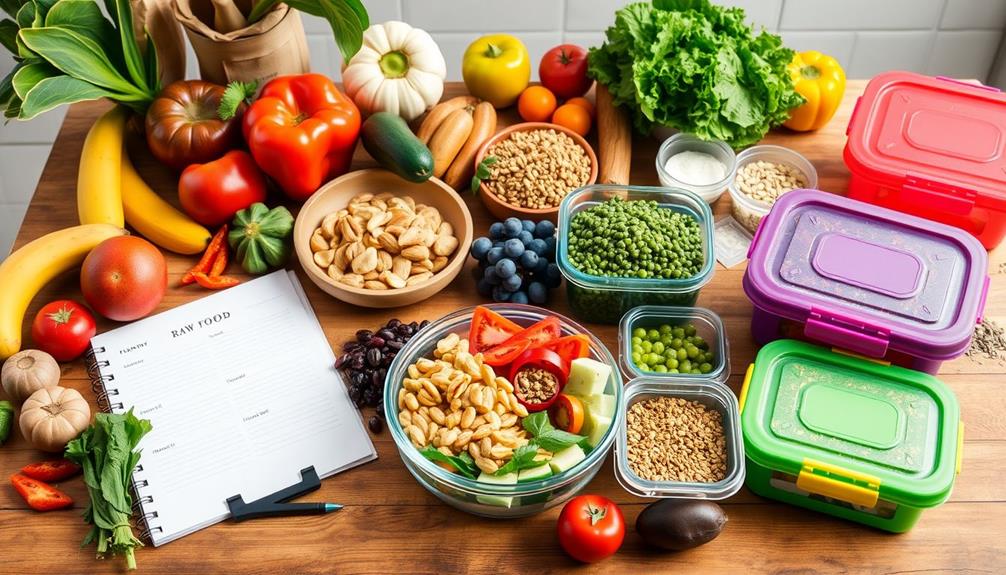
When you're starting a raw food diet, effective meal planning can make all the difference.
Incorporating various flavors and textures in your meals can enhance your dining experience, similar to how different brewing methods affect the aroma of coffee various brewing methods.
Focus on essential meal prep tips and simple recipe ideas that fit your lifestyle.
This approach helps you stay organized and enjoy a variety of nutritious meals without feeling overwhelmed.
Essential Meal Prep Tips
Meal prepping is essential for anyone starting a raw food diet, as it helps you stay organized and committed to healthier eating habits. To make your meal preparation effective and enjoyable, follow these essential tips:
- Invest in Kitchen Tools: Equip yourself with high-speed blenders, food processors, and dehydrators to simplify the creation of raw meals. Utilizing the right tools can enhance your overall cooking experience and efficiency, similar to mastering advanced mixing techniques in music production.
- Create a Weekly Menu: Plan a diverse menu featuring smoothies, salads, and snacks. This variety guarantees a balanced diet and keeps your nutrient intake high while preventing boredom.
- Incorporate Soaking and Sprouting: Use soaking and sprouting techniques for legumes and grains to enhance their digestibility and boost nutrient availability in your raw food preparations.
- Store Prepped Ingredients: Keep chopped fruits and vegetables in airtight containers. This not only maintains freshness but also makes healthy foods readily available for snacking throughout the week.
Don't hesitate to experiment with a 7-day meal plan that includes different recipes for breakfast, lunch, dinner, and snacks. This approach will ease your shift into the raw food diet and help you thrive on your journey.
Simple Recipe Ideas
Starting a raw food diet can feel overwhelming, but simple recipe ideas can make the shift easier and more enjoyable. Here's a quick meal plan to get you started:
| Meal | Recipe Idea | Key Ingredients |
|---|---|---|
| Breakfast | Green smoothie | Fresh spinach, kale, banana, almond milk |
| Lunch | Colorful salad | Fresh vegetables, nut-based dressing |
| Snack | Raw nut bars | Blended dates, almonds, chia seeds |
| Dinner | Zucchini noodles with tomato sauce | Zucchini noodles, raw tomato, basil |
| Dessert | Blended frozen bananas with raw cacao powder | Frozen bananas, raw cacao powder |
Kick off your day with a nutritious green smoothie packed with vitamins. For lunch, enjoy a colorful salad featuring a variety of fresh vegetables, topped with a nut-based dressing for healthy fats. Snack on homemade raw nut bars for a quick energy boost. For dinner, try zucchini noodles as a low-carb alternative, paired with a fresh tomato and basil sauce. Finally, satisfy your sweet tooth with a simple dessert made of blended frozen bananas and raw cacao powder. This meal plan showcases delicious recipe ideas to help you thrive on your raw food diet!
Personalization and Flexibility
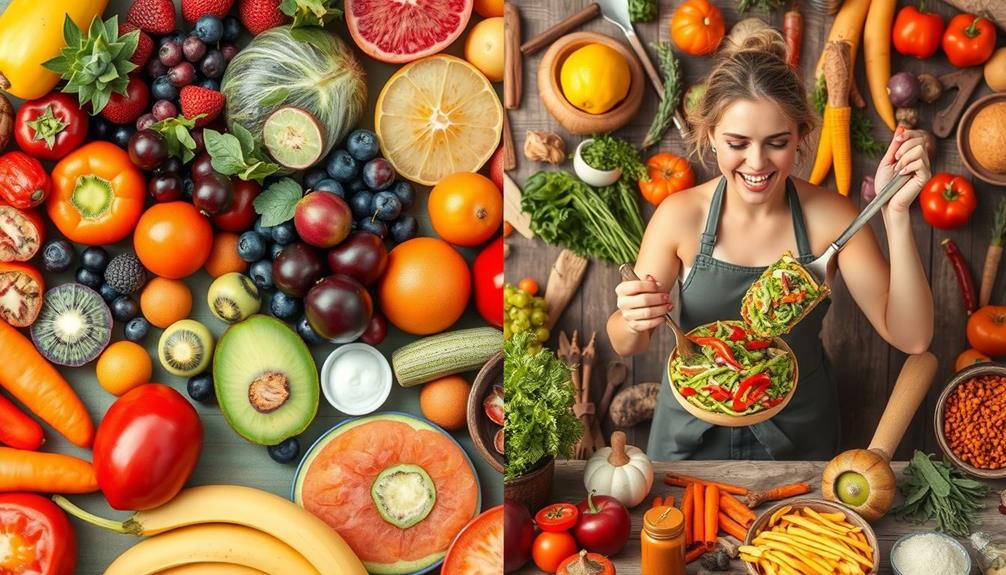
How do you make the raw food diet work for you? Personalization and flexibility are key. You can adjust the diet according to your individual dietary needs and health goals, allowing you to thrive on raw ingredients without feeling restricted. Here are a few strategies to take into account:
- Vary the Ratio: Experiment with a 1:3 ratio of raw to cooked foods for ideal nutrition and better digestibility. This approach can help maintain balance in your meals while still reaping the benefits of raw ingredients, similar to how yoga for back pain emphasizes a holistic approach to well-being.
- Incorporate Cooked Foods: Think about a raw omnivorous approach that includes limited cooked foods to meet your nutritional requirements while focusing on raw ingredients.
- Transition Gradually: If you're coming from a vegetarian diet, increase your raw food intake slowly to help your body adjust comfortably.
- Listen to Your Body: Personal choice plays a significant role; adapt the diet based on how you feel and your lifestyle factors, such as exercise or health conditions.
Final Thoughts on Raw Diets
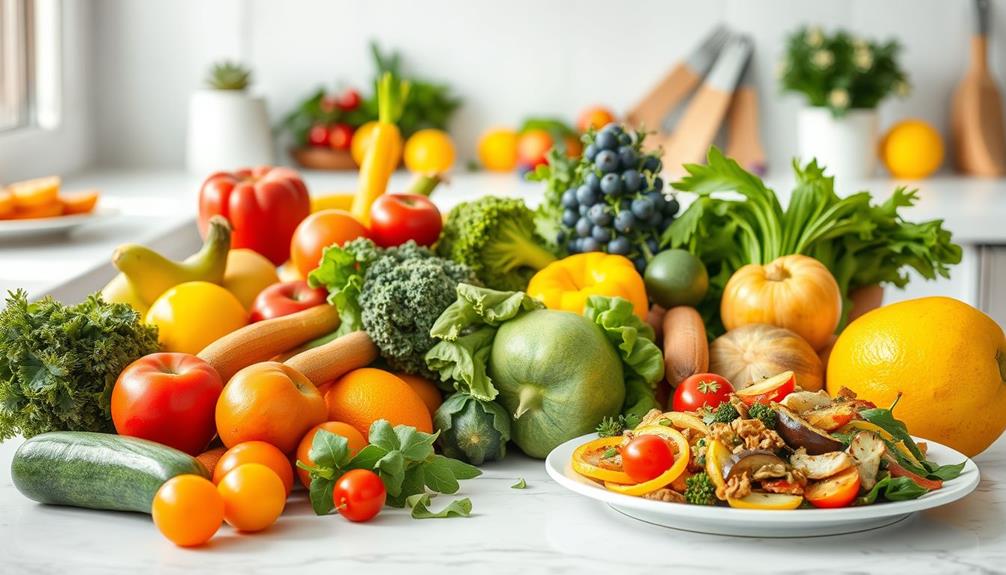
The raw food diet offers a unique approach to nutrition, emphasizing unprocessed, whole foods that can lead to numerous health benefits. By focusing on fruits, vegetables, nuts, and seeds, you may experience potential weight loss and a reduced risk of chronic diseases. This aligns with the idea of a balanced diet rich in fruits for overall health.
However, strict adherence to this diet can pose challenges. Nutritional deficiencies, particularly in vitamin B12 and protein, may arise from avoiding cooked foods that enhance nutrient absorption.
While eating raw foods can lead to increased energy and improved digestion, cooking food often makes certain nutrients more bioavailable and some foods safer. The restrictive nature of raw diets can foster disordered eating patterns, making it hard for many to maintain long-term. Additionally, the high cost and time-consuming meal prep can deter you from sticking with this lifestyle.
Ultimately, if you're considering a raw food diet, it's crucial to weigh both the benefits and health risks carefully. Balance is key; incorporating a variety of foods, including some cooked options, might provide a more sustainable and nutritionally complete approach to your dietary needs.
Always consult a healthcare professional before making significant dietary changes.
Frequently Asked Questions
What Are the Pros and Cons of the Raw Food Diet?
The raw food diet offers benefits like increased nutrient intake and weight loss, but it also poses risks including nutritional deficiencies and foodborne illnesses. You'll need to weigh these factors carefully before committing to it.
What Are the Negative Effects of Raw Food Diet?
When you follow a raw food diet, you might face nutritional deficiencies, digestive issues, and increased risk of foodborne illnesses. You could also experience fatigue and social challenges due to its restrictive nature.
What Are Two Advantages of Eating Raw Foods?
Eating raw foods boosts your vitamin and mineral intake, enhancing digestion and overall health. You'll also enjoy lower calorie content, which can support weight loss and help maintain lower body fat levels for a healthier lifestyle.
What Are the Pros and Cons of Unpasteurized Foods?
Imagine a double-edged sword; unpasteurized foods can boost your gut health with probiotics, yet they also carry the risk of harmful pathogens. Weigh the benefits against potential dangers before diving into this dietary choice.
Conclusion
To summarize, while a raw food diet can boost your intake of vitamins and enzymes, it's crucial to weigh both its benefits and drawbacks. Notably, studies show that nearly 80% of raw food enthusiasts report increased energy levels. However, without careful planning, you might miss out on essential nutrients found in cooked foods. Ultimately, whether you embrace a raw diet or not, finding a balance that suits your lifestyle and nutritional needs is key.

